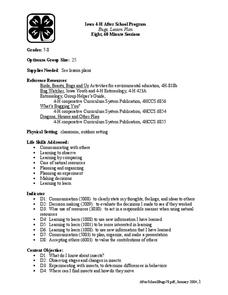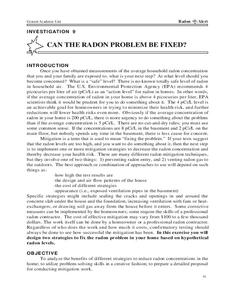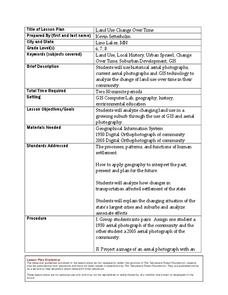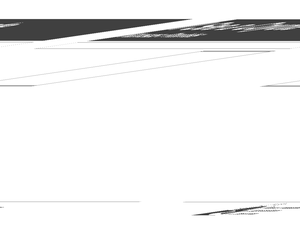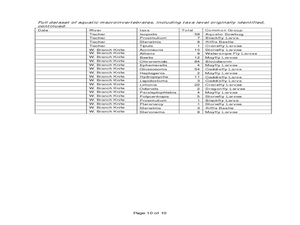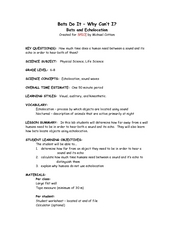Curated OER
environment: Fresh and Saltwater Habitats
Students compare and contrast fresh and salt water coastal environments. After describing how sea animals adapt to their habitats, they design a variety of sea creatures and explain how the adaptations aid in the animals' survival. ...
Curated OER
The Science of Color
Learners use the scientific method to explore how to make different colors with paint. They problem solve ways to darken and lighten colors without using black and white paint. Students hypothesize how to create new colors, and describe...
Curated OER
Owl Pellets
Sixth graders investigate the role of owls in their ecosystem. In this food chain lesson, 6th graders illustrate an owl food chain, dissect an owl pellet, and analyze data. Students discuss what would happen to owls if there were an...
Curated OER
'Round and 'Round it Goes!
Students discuss and interpret background knowledge on poster copy given on the water cycle. Students complete the included activity sheets using the poster as a reference in small groups. Students identify and name where water can be...
Curated OER
It'll Go With the Flow...
Students construct a water table elevation contour map and consider the direction and rate of groundwater flow to predict the actual runoff pattern. They discuss their findings and evaluate a hypothetical landfill site based on data...
Curated OER
Where Does it Come From?...Where Does it Go?
Learners summarize and illustrate how a water treatment plant and wastewater treatment plant work. Students describe the source of water for their community and the adequacy of groundwater to meet the community's needs. Learners also...
Curated OER
Radioactivity Experiments
Young scholars study the difference between types of ionizing radiation and how elements are transmuted. They determine that radiation is normal and surrounds us. They calculate the amounts of alpha, beta and gamma radiation emitted...
Curated OER
Electromagnetic Spectrum
High schoolers define electromagnetic radiation, list major categories and uses of electromagnetic waves, identify potential health risks with electromagnetic waves, and demonstrate understanding of Plank's constant by solving...
Curated OER
The Dangers of Illiteracy
Students consider a fictional situation in which literacy could spell the difference between life and death. They apply their knowledge of how reading empowers people by creating a literacy program that addresses the special needs of a...
Curated OER
Avoiding Carbon Dioxide Emissions from Burning Fossil Fuels
Students calculate stoichiometrically the amount of carbon dioxide that would be emitted from burning a mole of varios alkanes that comprise fossile fuels. If the energy released from burning a mole of these alkanes is known, then the...
Curated OER
Choices Make A Difference
Students are explained that wastewater treatment plants are regulated as to the quality of water they may discharge into our rivers and canals. They are explained that wastewater treatment plants clean many pollutants out of the...
Curated OER
Bugs
Students participate in an after school program that promotes communicating with others, observing one's environment, how to take care of natural resources, making decisions and learning how to just have fun. They explore the world of...
Curated OER
Bugs
Students participate in an after school program that promotes communications skills, hypothesizing, exploring, recording of data, leadership roles and making comparisons. They explore the world of insects, where they come from, how they...
Curated OER
Hyperlink Habitats
Students explore an online Hyperlink Habitat to illustrate the interconnectedness of a tropical rainforest ecosystem. They create a map of the Hyperlink Habitat and research a local ecosystem and create their own print or Web version of...
Curated OER
The Awful 8: The Play
Students perform a play based on pollution. In this pollution science lesson plan, students perform a play about different pollutants and how it effects our daily lives.
Curated OER
Can The Radon Problem Be Fixed?
In this radon worksheet, young scholars analyze their homes to identify sources of radon in their homes. They determine the best mitigation strategy to be used to reduce the radon and they discuss the advantages and disadvantages of...
Curated OER
Trout Are Made of Trees Crayon Mural
Learners recognize that for a trout habitat to be ideal, several components must be present. In this trout lesson, students explore what makes a healthy stream. Learners create paintings for a mural of a trout habitat....
Curated OER
Wood You Believe: Wood Products
In this wood products lesson plan, students walk to a forest near their school where they sit by themselves for a few minutes and quietly observe their surroundings. Students brainstorm wood or wood by products, discuss everything we get...
Curated OER
Land Use Change Over Time
Students use historical aerial photographs and current aerial photographs to compare the change over time to the land. In this land changing lesson plan, students analyze, compare, contrast, and list the land change in their own community.
Curated OER
Acid Mine Drainage
Young scholars use cabbage, backing soda, cobblestones, and more to test the acid in the water. In this acid mine damage lesson plan, students complete 13 experiments to test and treat acid.
Curated OER
I See a Coyote
Students role-play coyotes looking for natural resources. In this natural resources lesson, students examine the relationship between animal life and the environment. Students play a game that demonstrates how natural...
Curated OER
Meet the Press: American Presidents
High schoolers interpret historical evidence presented in primary and secondary resources. In this presidential history instructional activity, students research the accomplishments of George Washington, Abraham Lincoln, Frankiln D....
Curated OER
Aquatic Invertebrates
Students examine the impact that human development has on streams. In this stream sampling lesson students compare macroinvertebrate data and graph it.
Curated OER
Bats Do It-Why Can't I?
Students explore echos and how they are utilised in navigation. In this sound instructional activity students calculate the amount of time between a sound and its echo.











